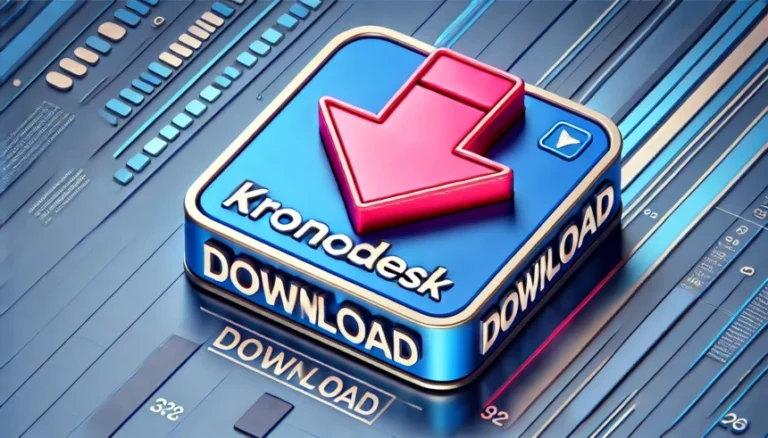Introduction
KronoDesk is a comprehensive customer support and helpdesk software designed to streamline ticket management, customer inquiries, and knowledge base organization. As businesses continue to evolve in an increasingly digital environment, tools like KronoDesk become indispensable for enhancing customer satisfaction and operational efficiency. In this guide, we explore the essential aspects of downloading, installing, and optimizing KronoDesk for your organization’s support needs.
1. Why Choose KronoDesk for Your Business?
KronoDesk offers a powerful suite of tools tailored for customer support teams seeking seamless ticket management, an integrated knowledge base, and robust customer forums—all in a single platform. Its user-friendly interface allows teams to track and resolve customer issues efficiently while empowering users to find answers independently through a rich self-service knowledge base.
Unlike generic helpdesk tools, KronoDesk is highly customizable, enabling businesses to adapt it to their specific workflows. The platform supports advanced automation for ticket routing, escalation, and priority management, saving valuable time and reducing response delays. Additionally, the analytics dashboard provides detailed insights into customer service performance, allowing managers to optimize processes and improve resolution rates. These features make KronoDesk an excellent investment for organizations aiming to boost productivity and customer satisfaction.
2. How to Download and Install KronoDesk
Downloading and installing KronoDesk is a straightforward process, but it requires careful attention to system requirements and setup instructions to ensure a smooth deployment. The first step is visiting the official KronoDesk website and navigating to the downloads section. Depending on your licensing agreement, you may need to log in with your customer credentials to access the latest version.
Before initiating the download, verify that your system meets the minimum technical specifications, including server requirements, storage capacity, and supported operating systems. KronoDesk typically runs on Windows Server environments, with database support for SQL Server or MySQL. Once the installer file is downloaded, follow the on-screen instructions, paying close attention to configuration options such as database connection settings and email server integration. Completing the installation successfully sets the foundation for a fully functional helpdesk solution tailored to your business needs.
3. Customizing KronoDesk for Maximum Efficiency
Customization is one of KronoDesk’s greatest strengths, allowing businesses to adapt its features to match specific customer service workflows. Start by configuring the ticketing system’s categories, priorities, and status options to align with your organization’s unique processes. Custom fields can be added to capture additional information specific to your industry or customer needs, ensuring that support agents have all the necessary data at their fingertips.
Beyond the ticketing system, the knowledge base can be organized into searchable topics and categories to make it easy for customers to find answers without contacting support directly. Use KronoDesk’s built-in editor to create detailed articles, complete with images, links, and formatting for clarity. Forums can also be tailored to promote community-driven support, enabling customers to share experiences and solutions. With these customizations, KronoDesk becomes a highly efficient and user-centric support platform.
4. Integrating KronoDesk with Existing Systems
KronoDesk offers integration capabilities that enhance its functionality and streamline business operations. For example, it can be connected to customer relationship management (CRM) systems to provide a 360-degree view of customer interactions. This integration allows support agents to access customer histories directly from their KronoDesk dashboard, leading to more personalized and informed responses.
Email integration is another critical feature that automates ticket creation from incoming messages. By linking your email server with KronoDesk, support inquiries sent to a designated email address are automatically logged as tickets, complete with relevant metadata. Additionally, KronoDesk’s API allows developers to build custom integrations with third-party applications, such as Slack for notifications or billing software for tracking customer subscriptions. Leveraging these integrations maximizes KronoDesk’s value and enhances your business’s overall support ecosystem.
5. Troubleshooting Common Installation and Configuration Issues
While KronoDesk is designed to be user-friendly, installation and configuration can sometimes pose challenges. Common issues include incorrect database configurations, email server misconfigurations, or firewall restrictions that prevent communication between the server and external systems. To resolve these problems, start by reviewing the error logs generated during installation—these logs often provide detailed messages that point to the root cause.
For database connection issues, ensure that the correct credentials and port numbers are specified. If email notifications are not functioning, verify the SMTP settings and ensure that authentication protocols are properly configured. Network-related problems may require adjustments to firewall or antivirus software to allow KronoDesk traffic. Consulting the official documentation and community forums can provide additional guidance. If issues persist, reaching out to KronoDesk’s technical support team ensures that you receive expert assistance.
6. Enhancing User Experience with KronoDesk
A well-implemented helpdesk system is only as effective as its user experience. To optimize KronoDesk for both agents and customers, consider customizing the user interface to reflect your brand’s identity. Change color schemes, add a company logo, and personalize email templates to create a cohesive customer experience. Additionally, provide training sessions for support staff to familiarize them with KronoDesk’s advanced features, such as automation rules and reporting tools.
Encourage customers to engage with the knowledge base and forums by regularly updating content with FAQs, tutorials, and troubleshooting guides. A proactive approach to self-service resources reduces ticket volume and empowers users to solve problems independently. Collect feedback from both customers and agents to continuously refine your KronoDesk setup, ensuring it remains a dynamic and effective solution for your evolving business needs.
Conclusion
KronoDesk is a robust and versatile platform that transforms how businesses manage customer support. From downloading and installation to customization and integration, every aspect can be tailored to deliver exceptional service experiences. By investing in the right setup and continuous improvement, organizations can harness the full potential of KronoDesk to enhance efficiency, reduce response times, and ultimately increase customer satisfaction.
